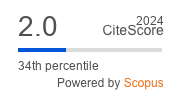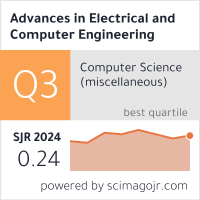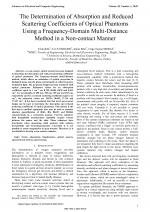| 2/2020 - 1 | View TOC | « Previous Article | Next Article » |
| Extra paper information in |
| Click to see author's profile in |
| Download PDF |
Author keywords
absorption, biophotonics, optical sensors, optoelectronic devices, spectroscopy
References keywords
optical(12), biomed(12), properties(11), spectroscopy(9), infrared(9), frequency(8), domain(7), measurements(6), measurement(6), scattering(5)
Blue keywords are present in both the references section and the paper title.
About this article
Date of Publication: 2020-05-31
Volume 20, Issue 2, Year 2020, On page(s): 3 - 10
ISSN: 1582-7445, e-ISSN: 1844-7600
Digital Object Identifier: 10.4316/AECE.2020.02001
Web of Science Accession Number: 000537943500001
SCOPUS ID: 85087446239
Abstract
A non-contact optical system has been designed to determine the absorption and reduced scattering coefficients of optical phantoms. The frequency-domain multi-distance method, which allows an estimation of optical properties in biological tissue uses the phase and intensity of radio frequency modulated light. The proposed design has been evaluated with optical phantoms. Estimated values for an absorption coefficient equal to 1 cm-1 are 0.795, 0.690, 0.670 and 0.613 cm-1 for wavelengths of 658 nm, 705 nm, 785 nm and 833 nm, respectively and for a reduced scattering coefficient equal to 22 cm-1, the estimated values are 19.876, 18.845, 17.134 and 17.927 cm-1. It has been concluded that this novel non-contact design can be used to determine the absorption and reduced scattering coefficients of optical phantoms. This system is the first step in medical equipment that may be used to measure absolute quantification of HbO, Hb, HbCO and HbMet concentrations in a contactless manner. Current oximeters with hemoglobin measurement capability require contact between the sensor and the skin. These oximeters have drawbacks when measuring child patients with asthma, bronchiolitis and bronchopneumonia. Currently it is not possible to assess oxygenation in open wounds. Therefore, it is worthwhile to develop a non-contact oximeter. |
| References | | | Cited By «-- Click to see who has cited this paper |
| [1] S.-S. Lin, R. Paramesran, Y.-P. Yu, "Dynamic heart rate measurements from video sequences using canonical component analysis", Adv. Electr. Comput. Eng., vol. 19, no. 3, pp. 41-48, 2019. [CrossRef] [Full Text] [SCOPUS Times Cited 3] [2] C. Rotariu, V. Manta, R. Ciobotariu, "Integrated system based on wireless sensors network for cardiac arrhythmia monitoring", Adv. Electr. Comput. Eng., vol. 13, no. 1, pp. 95-100, 2013. [CrossRef] [Full Text] [SCOPUS Times Cited 11] [3] F. Scholkmann et al., "A review on continuous wave functional near-infrared spectroscopy and imaging instrumentation and methodology", Celebr. 20 Years Funct. Infrared Spectrosc. FNIRS, vol. 85, pp. 6-27, Jan. 2014. [CrossRef] [SCOPUS Times Cited 1552] [4] P.-Y. Lin, S.-I. Lin, T. Penney, and J.-J. Chen, "Applications of near infrared spectroscopy and imaging for motor rehabilitation in stroke patients", J. Med. Biol. Eng., vol. 29, pp. 210-221, Jan. 2009. [5] Martin Wolf, Marco Ferrari, and Valentina Quaresima, "Progress of near-infrared spectroscopy and topography for brain and muscle clinical applications", J. Biomed. Opt., vol. 12, no. 6, pp. 1-14, Nov. 2007. [CrossRef] [SCOPUS Times Cited 536] [6] E. D. Chan, M. M. Chan, and M. M. Chan, "Pulse oximetry: understanding its basic principles facilitates appreciation of its limitations", Respir. Med., vol. 107, no. 6, pp. 789-799, Jun. 2013. [CrossRef] [SCOPUS Times Cited 494] [7] L. Lim, B. Nichols, N. Rajaram, and J. W. Tunnell, "Probe pressure effects on human skin diffuse reflectance and fluorescence spectroscopy measurements", J. Biomed. Opt., vol. 16, no. 1, pp. 011012-011012, 2011. [CrossRef] [SCOPUS Times Cited 102] [8] Judith R. Mourant, Oana C. Marina, Tiffany M. Hebert, Gurpreet Kaur, and Harriet O. Smith, "Hemoglobin parameters from diffuse reflectance data", J. Biomed. Opt., vol. 19, no. 3, pp. 1-10, Mar. 2014. [CrossRef] [SCOPUS Times Cited 13] [9] S. Ruderman et al., "Analysis of pressure, angle and temporal effects on tissue optical properties from polarization-gated spectroscopic probe measurements", Biomed. Opt. Express, vol. 1, pp. 489-499, Sep. 2010. [CrossRef] [SCOPUS Times Cited 23] [10] T. Li et al., "Simultaneous measurement of deep tissue blood flow and oxygenation using noncontact diffuse correlation spectroscopy flow-oximeter", Sci. Rep., vol. 3, pp. 1358-1358, 2013. [CrossRef] [SCOPUS Times Cited 87] [11] M. Hlavac, "Measurement of tissue optical properties", Czech Technical University in Prague, Faculty of Electrical Engineering, Prague, Czech Republic, 2013. [12] L. Spinelli et al., "Determination of reference values for optical properties of liquid phantoms based on intralipid and india ink", Biomed. Opt. Express, vol. 5, no. 7, pp. 2037-2053, Jul. 2014. [CrossRef] [SCOPUS Times Cited 157] [13] A. Dimofte, J. C. Finlay, and T. C. Zhu, "A method for determination of the absorption and scattering properties interstitially in turbid media", Phys. Med. Biol., vol. 50, no. 10, pp. 2291-2311, May 2005. [CrossRef] [SCOPUS Times Cited 108] [14] H. G. Akarcay, S. Preisser, M. Frenz, and J. RiÄka, "Determining the optical properties of a gelatin TiO(2) phantom at 780 nm", Biomed. Opt. Express, vol. 3, no. 3, pp. 418-434, Mar. 2012. [CrossRef] [SCOPUS Times Cited 38] [15] W. Chen et al., "Reference-free determination of tissue absorption coefficient by modulation transfer function characterization in spatial frequency domain", Biomed. Eng. OnLine, vol. 16, no. 1, p. 100, Aug. 2017. [CrossRef] [SCOPUS Times Cited 5] [16] J. P. Angelo, M. van de Giessen, and S. Gioux, "Real-time endoscopic optical properties imaging", Biomed. Opt. Express, vol. 8, no. 11, pp. 5113-5126, Oct. 2017. [CrossRef] [SCOPUS Times Cited 45] [17] A. Rehman, K. Rehman, S. Anwar, S. Firdous, and M. Nawaz, "Optical parameter measurement of highly diffusive tissue body phantoms with specifically designed sample holder for photo diagnostic and PDT applications", presented at the Proc. SPIE, 2015, vol. 9668. [CrossRef] [SCOPUS Times Cited 1] [18] T. Kono, J. Yamada, "In vivo measurement of optical properties of human skin for 450-800 nm and 950-1600 nm wavelengths", Int J Thermophys, p. 40:51, 2019. [CrossRef] [SCOPUS Times Cited 51] [19] X. Zhang and A. Webb, "Detectability of absorption and reduced scattering coefficients in frequency-domain measurements using a realistic head phantom", Sensors, vol. 13, no. 1, pp. 152-164, Dec. 2012. [CrossRef] [SCOPUS Times Cited 4] [20] J. B. Fishkin, P. T. C. So, A. E. Cerussi, S. Fantini, M. A. Franceschini, and E. Gratton, "Frequency-domain method for measuring spectral properties in multiple-scattering media: methemoglobin absorption spectrum in a tissue like phantom", Appl. Opt., vol. 34, no. 7, pp. 1143-1155, Mar. 1995. [CrossRef] [SCOPUS Times Cited 108] [21] H. Xu and M. S. Patterson, "Determination of the optical properties of tissue-simulating phantoms from interstitial frequency domain measurements of relative fluence and phase difference", Opt. Express, vol. 14, no. 14, pp. 6485-6501, Jul. 2006. [CrossRef] [SCOPUS Times Cited 42] [22] K. Tahir and C. Dainty, "Experimental measurements of light scattering from samples with specified optical properties", J. Opt. Pure Appl. Opt., vol. 7, p. 207, Mar. 2005. [CrossRef] [SCOPUS Times Cited 13] [23] M. Dehaes et al., "Assessment of the frequency-domain multi-distance method to evaluate the brain optical properties: Monte Carlo simulations from neonate to adult", Biomed. Opt. Express, vol. 2, no. 3, pp. 552-567, Feb. 2011. [CrossRef] [SCOPUS Times Cited 76] [24] A. Bozkurt, A. Rosen, H. Rosen, and B. Onaral, "A portable near infrared spectroscopy system for bedside monitoring of newborn brain", Biomed. Eng. OnLine, vol. 4, no. 1, p. 29, Apr. 2005. [CrossRef] [SCOPUS Times Cited 142] [25] S. Spichtig, M. P. Wolf, and M. Rudin, "Multi-distance and multi-frequency frequency-domain near-infrared spectroscopy characterization and application", ETH, 2010. [CrossRef] [26] S. Fantini, M. A. Franceschini, and E. Gratton, "Semi-infinite-geometry boundary problem for light migration in highly scattering media: a frequency-domain study in the diffusion approximation", J. Opt. Soc. Am. B, vol. 11, no. 10, pp. 2128-2138, Oct. 1994. [CrossRef] [SCOPUS Times Cited 219] [27] Y. Yamashita, A. Maki, and H. Koizumi, "Wavelength dependence of the precision of noninvasive optical measurement of oxy-, deoxy-, and total-hemoglobin concentration", Med. Phys., vol. 28, no. 6, pp. 1108-1114, Jun. 2001. [CrossRef] [SCOPUS Times Cited 93] [28] Teresa M. Correia, Adam P. Gibson, and Jeremy C. Hebden, "Identification of the optimal wavelengths for optical topography: a photon measurement density function analysis", J. Biomed. Opt., vol. 15, no. 5, pp. 1-14, Sep. 2010. [CrossRef] [SCOPUS Times Cited 27] [29] H. Sato, M. Kiguchi, F. Kawaguchi, and A. Maki, "Practicality of wavelength selection to improve signal-to-noise ratio in infrared spectroscopy", NeuroImage, vol. 21, pp. 1554-62, May 2004. [CrossRef] [SCOPUS Times Cited 118] [30] D. Arifler, T. Zhu, S. Madaan, and I. Tachtsidis, "Optimal wavelength combinations for near-infrared spectroscopic monitoring of changes in brain tissue hemoglobin and cytochrome c oxidase concentrations", Biomed. Opt. Express, vol. 6, no. 3, pp. 933-947, Mar. 2015. [CrossRef] [SCOPUS Times Cited 49] [31] W. G. Zijlstra, A. Buursma, and W. P. Meeuwsen-van der Roest, "Absorption spectra of human fetal and adult oxyhemoglobin, de-oxyhemoglobin, carboxyhemoglobin, and methemoglobin.", Clin. Chem., vol. 37, no. 9, p. 1633, Sep. 1991. [CrossRef] [32] T. Sahin, "Near-infrared spectroscopy system for monitoring Peripheral Vascular Disease.", 2003. Web of Science® Citations for all references: 0 SCOPUS® Citations for all references: 4,117 TCR Web of Science® Average Citations per reference: 0 SCOPUS® Average Citations per reference: 125 ACR TCR = Total Citations for References / ACR = Average Citations per Reference We introduced in 2010 - for the first time in scientific publishing, the term "References Weight", as a quantitative indication of the quality ... Read more Citations for references updated on 2025-07-03 02:28 in 192 seconds. Note1: Web of Science® is a registered trademark of Clarivate Analytics. Note2: SCOPUS® is a registered trademark of Elsevier B.V. Disclaimer: All queries to the respective databases were made by using the DOI record of every reference (where available). Due to technical problems beyond our control, the information is not always accurate. Please use the CrossRef link to visit the respective publisher site. |
Faculty of Electrical Engineering and Computer Science
Stefan cel Mare University of Suceava, Romania
All rights reserved: Advances in Electrical and Computer Engineering is a registered trademark of the Stefan cel Mare University of Suceava. No part of this publication may be reproduced, stored in a retrieval system, photocopied, recorded or archived, without the written permission from the Editor. When authors submit their papers for publication, they agree that the copyright for their article be transferred to the Faculty of Electrical Engineering and Computer Science, Stefan cel Mare University of Suceava, Romania, if and only if the articles are accepted for publication. The copyright covers the exclusive rights to reproduce and distribute the article, including reprints and translations.
Permission for other use: The copyright owner's consent does not extend to copying for general distribution, for promotion, for creating new works, or for resale. Specific written permission must be obtained from the Editor for such copying. Direct linking to files hosted on this website is strictly prohibited.
Disclaimer: Whilst every effort is made by the publishers and editorial board to see that no inaccurate or misleading data, opinions or statements appear in this journal, they wish to make it clear that all information and opinions formulated in the articles, as well as linguistic accuracy, are the sole responsibility of the author.



